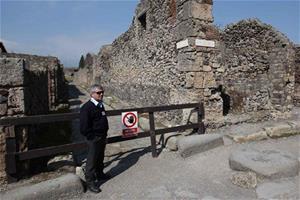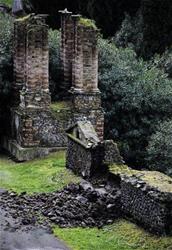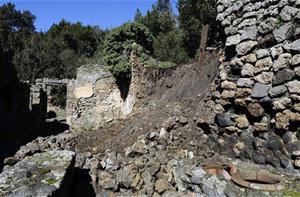Read the article below and study the sources.
What kind of challenges face Pompeii in terms of conservation? What sites have thus far been affected?

A man stands by the area where thieves pried off a chunk of an ancient fresco of the Greek goddess Artemis from the walls of Pompeii, Italy, Tuesday, March 18, 2014. (AP Photo/Marco Cantile, Lapresse)
The problems in Pompeii keep piling up—and crumbling down. Just weeks after portions of two of its structures collapsed under heavy rainfall, the ancient city has become the victim of theft, Reuters reports. A custodian discovered that thieves had last Wednesday taken an eight-inch fragment from a fresco showing the goddess Artemis that is located in the House of Neptune. The portion was “chiseled off with a metallic object” in an area closed to the public, the site’s curation department explained in a statement yesterday, a revelation that has only added to frustrations about Pompeii’s maintenance and care—especially given that a new site superintendent was recently appointed, reports AFP.
The AFP describes the results of the theft dramatically, writing of “a glaring white slash in the pink-toned fresco where the god Apollo now stands forlornly alone.” The new superintendent says “everything is being done” to recover the fresco—though police will have no footage from directly inside the ruins to assist them; the only security cameras are perimeter ones. An archaeological expert, meanwhile, suggests petty criminals were at work, as “selling a stolen fresco from a site as well documented as Pompeii would be a very, very tall order. There would certainly not be any market for it in Italy.” Oddly, a fresco fragment previously stolen from Pompeii was anonymously mailed to the curator’s office in January.
(Source: Newser.com, 19 March 2014)

Bricks and rocks are seen on the ground after they collapsed in the ancient Roman city of Pompeii, Sunday, March 2, 2014. (APhoto/Salvatore La Porta)

Bricks and rocks are seen on the ground after a section of wall around an ancient shop collapsed in Pompeii as a consequence of a rainstorm, Monday, March 3, 2014. (AP Photo/Salvatore Laporta)
